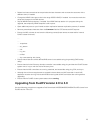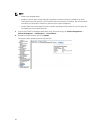• Delete local user names that have a period as the last character and re‐create the accounts with a
different name, if needed.
• Change the NDMP client port to be in the range 10000–10100, if needed. You must also make the
reciprocal change on the DMA servers.
• Stop all NDMP backup sessions, if needed. If an NDMP backup session is in progress during the
upgrade, the temporary NDMP snapshot is left in place.
• Open additional ports on your firewall to allow replication between replication partners, if needed.
• Remove parentheses characters from the Comment field for CIFS shares and NFS exports.
• Ensure the NAS volumes do not have the following names (these names are reserved for internal
FluidFS cluster functions):
– .
– ..
– .snapshots
– acl_stream
– cifs
– int_mnt
– unified
– Any name starting with locker_
• Ensure that at least one of the defined DNS servers is accessible using ping and dig (DNS lookup
utility).
• Ensure that the Active Directory domain controller is accessible using ping and that the FluidFS cluster
system time is in sync with the Active Directory time.
• Ensure that the NAS controllers are running, attached, and accessible using ping, SSH, and rsync.
• Although the minimum requirement to upgrade is that at least one NAS controller in each NAS
appliance must be running, Dell recommends ensuring that all NAS controllers are running before
upgrading.
• Ensure that the FluidFS cluster system status shows running.
Upgrading from FluidFS Version 2.0 to 3.0
Use the following procedure to upgrade a Dell PowerVault NX3500/NX3600/NX3610 FluidFS cluster from
FluidFS version 2.0 to 3.0.
25


















